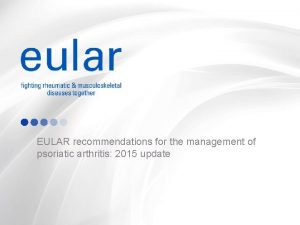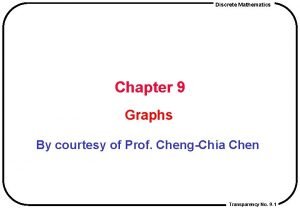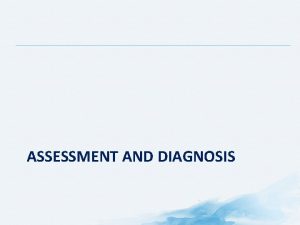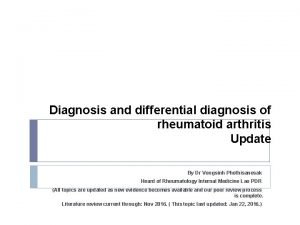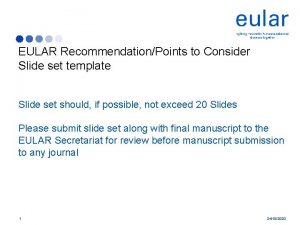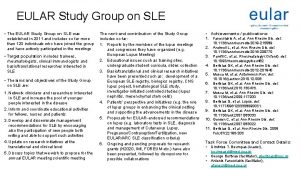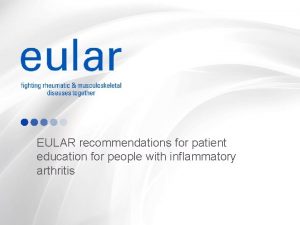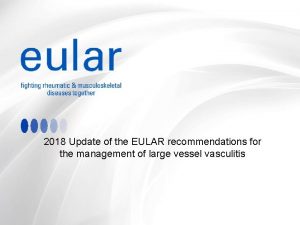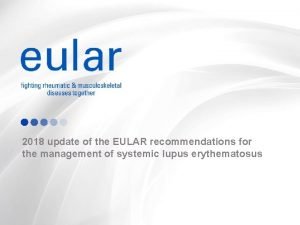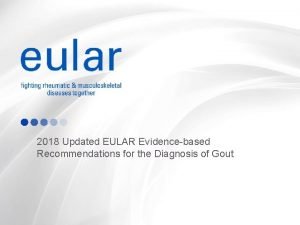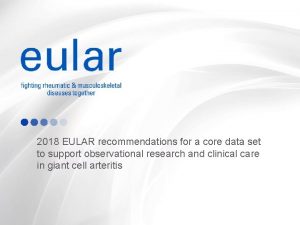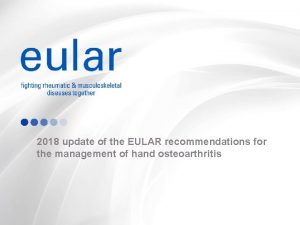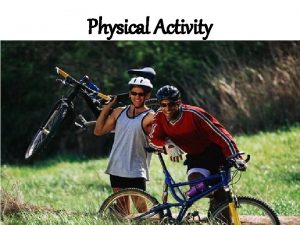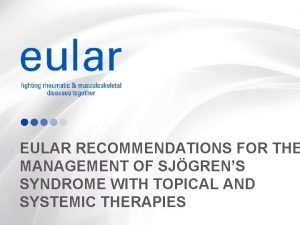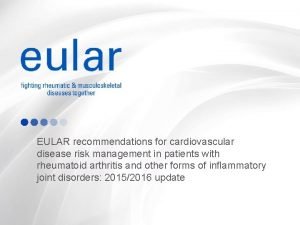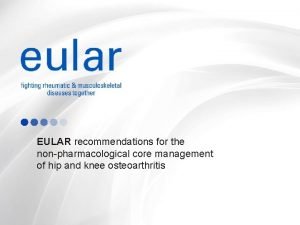2018 EULAR recommendations for physical activity in people















- Slides: 15

2018 EULAR recommendations for physical activity in people with inflammatory arthritis and osteoarthritis

Steps for developing recommendations (SOP) 2014 Update of the EULAR standardised operating procedures for EULAR-endorsed recommendations Van der Heijde D et al, 2014 2

The Task Force Steering Committee: • Karin Niedermann (Convenor; PT/CH); Thea Vliet Vlieland (methodologist; MD, PT/ NL); Jürgen Braun (Steering Committee member, MD/Ger); Anne-Kathrin Rausch (Fellow; PT/CH) Task Force Members • Joe Adams (OT/GB); Bente Appel Esbensen (RN/DK); Carsten Bogh Juhl (PT/DK); Nina Brodin (PT/Se); Hanne Dagfinrud (PT/No); Tuncay Duruöz (MD/Tr); Klaus-Peter Günther (MD/DE); Emalie Hurkmans (PT/ BE); Norelee Kennedy (PT/Ir); Uta Kiltz (MD/Ger); Keegan Knittle (Psychol/SF); Mike Nurmohamed (MD; NL); Sandra Pais (Human scientist/PT); Irene Pitsillidou (PRP/GR); Guy Severijns (PRP, BE); Thijs Swinnen (PT/BE); Warburton Louise (MD/GB); Zhivko Yankov (PRP/BG). 3 18/02/2021

Not on Picture: Hanne Dagfinrud; Emalie Hurkmans; Klaus-Peter Günther; Keegan Knittle; Guy Severijns 4

Definition of PA, exercise (and therapeutic exercise) • Physical activity (PA) is defined as any bodily movement produced by skeletal muscles that requires energy expenditure • Exercise is a subcategory of physical activity that is planned, structured, repetitive, and aims to improve or maintain one or more components of physical fitness. WHO: http: //www. who. int/topics/physical_activity/en/ • Therapeutic exercises are specific exercises address particular functional health problems. 5 meant to

The ACSM-Exercise Recommendations For systematic literature review: only ACSM-conform PA interventions Garber CE et al. , American College of Sports Medicine position stand. Quantity and quality of exercise…. Med Sci in Sports and exercise 2011; 43(7): 1334 -59. 6

PA Recommendations for which patients • Inflammatory arthritis (i. A): Rheumatoid Arthritis (RA) and Spondyloarthritis (Sp. A) • Osteoarthritis: Hip Osteoarthritis and Knee Osteoarthritis 7 18/02/2021

Results: Four Overarching Principles and Ten Recommendations

The PA recommendations for RA/Sp. A/OA (HOA/KOA) Overarching Principles 1. Physical activity is part of a general concept to optimize health related quality of life. 2. Physical activity has health benefits for people with RA/Sp. A/OA. 3. General physical activity recommendations including the four domains (cardiorespiratory fitness, muscle strength, flexibility and neuromotor performance) are applicable (feasible and safe) to people with RA/OA/Sp. A. 4. The planning of physical activity requires a shared decision between health care providers and people with RA/Sp. A/OA, which takes people’s preferences, capabilities, and resources into account. 9 18/02/2021

The PA recommendations for RA/Sp. A/OA (HOA/KOA) RECOMMENDATIONS CATEGORY OF EVIDENCE STRENGTH OF RECOMMENDATION 1. Promoting physical activity consistent with general PA recommendations should be an integral part of standard care throughout the course of disease in people with RA/Sp. A/OA. 1 B A 2. All health care providers involved in the management of people with RA/Sp. A/OA should take responsibility for promoting PA, and should cooperate, including making necessary referrals, to ensure that people with RA/Sp. A/OA receive appropriate PA interventions. 3. Physical activity interventions should be delivered by health care providers competent in their delivery to people with RA/Sp. A/OA. 4 4. Health care providers should evaluate the type, intensity, frequency, and duration of the people’s actual physical activity by means of standardized methods to identify which of the four domains of general physical activity recommendations can be targeted for improvement. 5. General and disease-specific contra-indications for physical activity should be identified and taken into account in the promotion of physical activity. 3 10 LEVEL OF AGREEMENT MEAN (SD) MEDIAN (RANGE) 9. 81 (0. 39) 10 (9 -10) D 9. 14 (0. 98) 9 (7 -10) 4 D 8. 86 (1. 48) 10 (5 -10) C 9. 05 (1. 04) 9 (6 -10) 4 D 9. 10 (1. 41) 10 (5 -10) 18/02/2021

The PA recommendations for RA/Sp. A/OA (HOA/KOA) RECOMMENDATIONS 6. Physical activity interventions should have clear personalized aims, which should be evaluated over time, preferably by use of a combination of subjective and objective measures (including self-monitoring when appropriate). 7. General and disease specific barriers and facilitators related to performing physical activity, including knowledge, social support, symptom control, and self -regulation should be identified and addressed. 8. Where individual adaptations to general physical activity recommendations are needed, these should be based on a comprehensive assessment of physical, social and psychological factors including fatigue, pain, depression, and disease activity. 9. Health care providers should plan and deliver physical activity interventions that include behaviour change techniques such as self-monitoring, goal setting, action planning, feedback and problem solving. 10. Health care providers should consider different modes of delivery of physical activity (e. g. supervised/not-supervised, individual/group, face-to-face/ online, booster strategies) in line with people’s preferences. 11 CATEGORY OF EVIDENCE 4 STRENGTH OF RECOMMENDATIO N D LEVEL OF AGREEMENT MEAN (SD) MEDIAN (RANGE) 9. 05 (1. 25) 9 (5 -10) 3 C 9. 19 (1. 13) 10 (6 -10) 4 D 9. 24 (0. 86) 9 (7 -10) 1 A A 9. 48 (0. 79) 10 (7 -10) 4 D 9. 00 (1. 30) 9 (5 -10) 18/02/2021

Research Agenda Research agenda for physical activity in people with inflammatory arthritis and osteoarthritis 1. To evaluate the long-term effectiveness of PA at different intensities and types, and monitoring of Adverse Events (AE). 2. To evaluate links between PA behaviour and disease specific outcomes. 3. To evaluate the long-term effectiveness of sedentary behavior reduction, including the monitoring of AE. 4. To evaluate links between sedentary behavior and disease specific outcomes. 5. To identify which PA intervention strategies work best to increase PA level and adherence in various subgroups. 6. To identify markers of response and non-response to PA treatment. 7. To identify disease specific contra-indications on different exercise domains (cardiovascular, strength, flexibility, neuromotor). 8. To further develop and evaluate strategies to reduce and monitor a change in sedentary behavior. 9. To develop PA interventions targeting all exercise dimensions simultaneously with special focus on feasibility. 10. To evaluate and recommend valid PA assessments feasible for the use in clinical practice. 11. To study how to facilitate PA behavior change immediately from screening onwards and how to address facilitators and barriers. 12. To identify facilitators and barriers of health care providers towards applying the PA recommendations. 13. To perform long-term effectiveness trials on combined interventions including other health behaviours. 12

Education Agenda 1. Increase knowledge about PA among HPs, physicians and people with inflammatory arthritis and osteoarthritis. 2. Increase HPs’ and physicians’ skills in communicating the role of PA in managing general health and disease specific issues. 3. Include knowledge and skills on PA promotion in all HPs’ and physicians’ undergraduate training curricula. 4. Develop a EULAR training module on PA for HPs and rheumatologists. 5. Propose a session on PA at every EULAR congress. 6. Develop patient education materials. 13 18/02/2021

Lay Summary and Implications • The 2018 EULAR recommendations for physical activity in people with inflammatory arthritis (IA) and osteoarthritis (OA) encompass a set of 4 overarching principles and 10 recommendations for PA in people with RA, ax. Sp. A and hip/knee OA (slides 9 -11), based on systematic literature reviews with qualitative and quantitative analysis, i. e. a meta-analysis. • The PA recommendations set the standards of PA that people with IA should (expect to) receive from their rheumatology HPs, including their rheumatologists. • The PA recommendations include all four fitness domains, i. e. cardiorespiratory fitness, muscle strength, flexibility and neuromotor performance, in appropriate dose, i. e. duration, frequency and intensity of PA, and consider PA as a behavioural intervention. • The development of the PA recommendations stimulated an educational agenda for HPs across European countries, as well as an agenda for future research in the field of PA (slides 12 -13). • The PA recommendations will be disseminated to patients, HPs and rheumatologists across Europe by publications, conferences, patient and professional organisations, EULAR website. • Given the different health systems across Europe, the PA recommendations should be implemented considering cultural implications, national health systems and people’s preferences, capabilities, and resources. 14 18/02/2021

Acknowledgement We thank • the librarians Mrs. José Plevier and Mr. Jan W. Schoones, Walaeus Library, Leiden University Medical Center, the Netherlands, for supporting our literature search • Christian Horvath, Zurich University of Applied Sciences, Switzerland, MSc student for his help in the Cochrane risk of bias assessment 15 18/02/2021
 Eular psoriatic arthritis guidelines
Eular psoriatic arthritis guidelines Graph discrete mathematics
Graph discrete mathematics Eular criteria for ra
Eular criteria for ra Eular
Eular Diagnosing rheumatoid arthritis
Diagnosing rheumatoid arthritis Acr eular criteria for ra
Acr eular criteria for ra Eular
Eular What is physical fitness test in mapeh
What is physical fitness test in mapeh Dada la siguiente secuencia rusia 2018 rusia 2018
Dada la siguiente secuencia rusia 2018 rusia 2018 Kontinuitetshantering i praktiken
Kontinuitetshantering i praktiken Novell typiska drag
Novell typiska drag Tack för att ni lyssnade bild
Tack för att ni lyssnade bild Ekologiskt fotavtryck
Ekologiskt fotavtryck Varför kallas perioden 1918-1939 för mellankrigstiden?
Varför kallas perioden 1918-1939 för mellankrigstiden? En lathund för arbete med kontinuitetshantering
En lathund för arbete med kontinuitetshantering Adressändring ideell förening
Adressändring ideell förening
